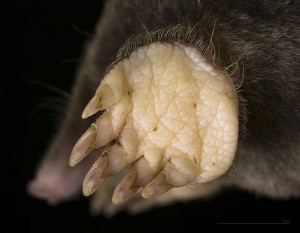Minnesota Mole Removal
Moles are not rodents, but relatives of the insectivores (insect eaters) such as shrews and hedgehogs. In their search for food, moles burrow in lawns, meadows, stream banks, and open woodlots, creating elaborate underground tunnels. They feed mainly on earthworms and insect larvae (grubs). Only rarely seen above ground, moles are 4 to 9 inches long, including the tail, with long dark gray or brown fur. Eyes are tiny, like a pinhead, and the tail and feet are usually pink. They have no visible ears.
Can’t figure out why your home or office flowerbeds are all torn up? Sounds like you may have a mole problem! Moles are one of the garden’s worst pests. Nothing can ruin the design of a gorgeous lawn or garden faster than moles.
As they burrow, they sometimes damage plants, but the major problem with moles is the mounds and ridges that disfigure lawns. As they tunnel just below the surface, moles raise the sod up with their front digging feet, looking for food or new tunneling sites. They can push up surface tunnels at the rate of a foot per minute if the soil is loose. They prefer loose, moist soil shaded by vegetation.
Except for breeding season in early spring, moles tend to live alone, so the multitunneled pattern in your yard is likely home to only one mole.
Moles build new feeding tunnels constantly and may not use the same one twice. You may find entry and exit mounds, which are usually round and symmetrical, pushed up volcano-fashion by the mole. The hole usually has dirt in it but remains visible. The mounds are connected to main runways. The runways are 12-18 inches underground and not usually visible.
Moles feed on insects and insect larvae, but their preferred dinner includes earthworms and white grubs. Given a choice, moles pick moist, sandy loam soils over dry, heavy clay soils. They are most active during warm, wet months, although they live underground year-round.
Moles have polydactyl forepaws; each has an extra thumb (also known as a prepollex) next to the regular thumb. While the mole’s other digits have multiple joints, the prepollex has a single, sickle-shaped bone which develops later and differently from the other fingers during embryogenesis from a transformed sesamoid bone in the wrist, independently evolved but similar to the giant panda thumb. This supernumerary digit is species-specific, as it is not present in shrews, the mole’s closest relatives.
Getting Rid of Mole Problems
The only sure way to eliminate a mole is to use a mole-specific trap. Environmentally friendly mole traps can be used for humane mole trapping. Repellants, poisons, fumigants, and home remedies are less effective.
Spring and fall, when the ground is moist but not frozen, are the best times of year for control because moles are most active then. It is important, however, to properly identify the source of this yard damage before setting out to trap the moles you think you have in your yard.
Moles may be a real dilemma for any homeowner. If moles are causing property damage and giving you a headache, calling a Minnesota Wild Animal Removal Expert ensures humane and effective removal of the moles and to be sure they will not return.




